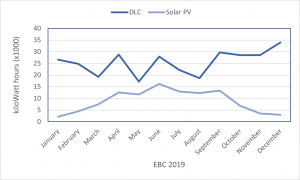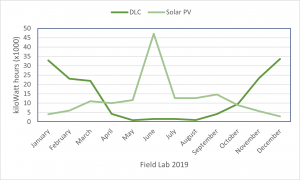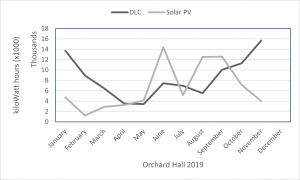As many of us know, Pennsylvania is a hot spot for fracking and the use of natural gas as an energy source. In 2019 alone, Pennsylvania’s net electricity generation was composed of natural gas supplying 49%, followed by nuclear at 34% and coal at 14%; Hydroelectric and other renewable energy sources only contributed around 3% to the net electricity generation in the state. While the use of natural gas is often thought of as a better alternative to coal because it produces less CO2, fracking for natural gas produces methane – a greenhouse gas significantly more potent than carbon dioxide. Additionally, the fracking operations are not required to report or manage the chemicals that they use in the fracking process, so many carcinogens and toxic chemicals end up getting leaked into our watersheds. There is no way to hold these companies accountable when health issues start to increase because the chemicals cannot legally be tracked back to their origin.
Here at Eden Hall, our energy usage in 2019 looks quite different from Pennsylvania as a whole, but we still have room to improve. In the newer buildings (the EBC, Cafe Ann, Field Lab, and Orchard Hall), the geothermal system takes care of our heating and cooling needs, so the following data only refers to the energy we produce and consume. However, this discussion does not touch on the amount of energy that the older buildings (the Lodge, Morledge House, etc.) consume from the grid for both heating and electricity needs. Additionally, the data for solar production from Cafe Ann is not included in this discussion largely because there was no corresponding data for how much energy was consumed in that structure (due to its lack of use). Keep in mind that although this structure does produce more energy than it consumes, its maximum solar output for any given week over the course of the past three years is a little over 200 kiloWatt hours. The following figures are measured in thousands of kWh.
For the Esther Barazzone Center in 2019, the amount of solar energy produced never surpassed the amount Eden Hall was charged for by the Duquesne Light Company. The overall trend makes sense seeing as how the deficit increases during the winter months and comes close to breaking even once we reached summer. Also, the original plan was for there to be additional solar panels in order for the EBC to be net-zero. This canopy setup was unable to come to fruition, but it is important to note that the amount of solar production showcased in Figure 1 was not the intended amount.

Figure 1: Energy usage in the Esther Barazzone Center

Figure 2: Energy usage in the Field Lab

Figure 3: Energy usage in Orchard Hall
In Figure 2, it is clear that it is possible to produce more solar energy than we need to pull from the grid. However, we still face the same large deficit once we get to the winter months. In Figure 3, we see that Orchard Hall also produces almost all of its electrical energy needs during the summer month. It should be noted that the data source for this graph had some discrepancies in the solar data, so the first half of the graph is not entirely accurate (the numbers used are most likely too low during April and July). However, the trends that we have seen before continue with the largest difference between energy used from the grid and energy that we produce occurring during the winter. What is important to understand here is that while Eden Hall has incorporated a lot of renewable energy systems and is headed in the right direction, we are still quite reliable on the fossil-fuel-based grid.
Biogas Usage
One potential solution for mitigating our dependency on fossil fuels via the grid is investing in biogas technology. Biogas is often created using animal manure, food waste, and other substances containing organic compounds. A CMU student-led start-up called Ecotone Renewables has created an anaerobic digestion system, the “Seahorse” (see below) with the bulk of the system contained within a 10×20 foot shipping container and a hydroponics greenhouse setup on top of it. This project can process about 385 pounds of food waste per week, and it produces about 50 gallons of fertilizer per week as well as methane gas for energy production. This could be beneficial for use at Eden Hall potentially with the older buildings because they are already set up to use natural gas from the grid that could be replaced with the gas produced from the Seahorse. While this system still includes the use of the highly potent greenhouse gas methane, we could begin the transition of the older buildings by sourcing our gas from food waste rather than fossil fuels. It is unclear if the Eden Hall campus would produce too little or too much food waste per week for this system, and their public resources do not share how much energy this system would generate at max capacity, but this project has the potential to help Eden Hall decrease our dependence on the grid and, by extension, fossil fuels.











